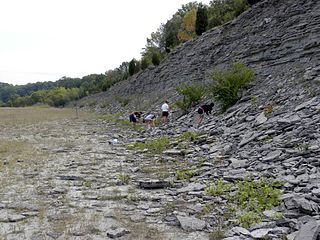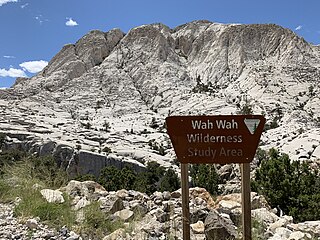Related Research Articles
The Poleta Formation is a geological unit known for the exceptional fossil preservation in the Indian Springs Lagerstätte, located in eastern California and Nevada.

The Cambrian Bright Angel Shale is the middle layer of the three member Tonto Group geologic feature. The 3-rock Tonto section famously sits upon the Great Unconformity because of the highly resistant cliffs of the base layer, vertical Tapeats Sandstone cliffs.

The Bull Fork Formation is a geologic formation in north central Kentucky and southwestern Ohio. It preserves fossils dating back to the Ordovician period.

The Graneros Shale is a geologic formation in the western United States, east of the Rocky Mountains. It preserves fossils dating back to the Cenomanian Age of the Cretaceous period.

The Abo Formation is a geologic formation in New Mexico. It contains fossils characteristic of the Cisuralian epoch of the Permian period.
The Ely Limestone is a geologic formation in Nevada and Utah. It preserves fossils dating back to the Carboniferous period.
The Ely Springs Dolomite is an Ordovician period geologic formation in the Southwestern United States.

The Crystal Peak Dolomite is a geologic formation in the Wah Wah Mountains of western Utah. It preserves fossils dating to the Middle Ordovician period.

The Campito Formation is a geologic formation in Nevada. It preserves fossils dating back to the Cambrian period.
The Deep Spring Formation is a geologic formation in Nevada. It preserves fossils dating back to the Cambrian period.
The Banner Formation is a Carboniferous period geologic formation in northern Elko County, Nevada.
The Diamond Peak Formation is a geologic formation in Nevada. It preserves fossils dating back to the Carboniferous period.
The Coils Creek Limestone is a geologic formation in Nevada. It preserves fossils dating back to the Devonian period.
The Vinini Formation is a marine, deep-water, sedimentary deposit of Ordovician to Early Silurian age in Nevada, U.S.A. It is notable for its highly varied, mainly siliceous composition, its mineral deposits, and controversies surrounding both its depositional environment and structural history. The formation was named by Merriam and Anderson for an occurrence along Vinini Creek in the Roberts Mountains of central Nevada and that name is now used extensively in the State.
The Windfall Formation is a geologic formation in northeastern and southern Nevada.
The Johnson Spring Formation is a geologic formation in California. It preserves fossils dating back to the Ordovician period.
The Al Rose Formation is a geologic formation in California. It consists mostly of siltstone, mudstone and shale, with some chert and occasional limestone. In it are found graptolite and trilobite fossils dating back to the Ordovician period.

The Bisbee Group is a geologic group in Arizona, Mexico, and New Mexico. It preserves fossils dating back to the early Cretaceous period.
The Bigfork Chert is a Middle to Late Ordovician geologic formation in the Ouachita Mountains of Arkansas and Oklahoma. First described in 1892, this unit was not named until 1909 by Albert Homer Purdue in his study of the Ouachita Mountains of Arkansas. Purdue assigned the town of Big Fork in Montgomery County, Arkansas as the type locality, but did not designate a stratotype. As of 2017, a reference section for this unit has yet to be designated. The Bigfork Chert is known to produce planerite, turquoise, variscite, and wavellite minerals.
The Stanley Shale, or Stanley Group, is a Mississippian stratigraphic unit in the Ouachita Mountains of Arkansas and Oklahoma. First described in Arkansas in 1892, this unit was not named until 1902 by J.A. Taff in his study of the Ouachita Mountains of Oklahoma. Taff assigned the town of Stanley in Pushmataha County, Oklahoma as the type locality, but did not designate a stratotype. After introduction into Arkansas in 1909 by Albert Homer Purdue, the unit was redefined in 1918, when the formation known as the Fork Mountain Slate was abandoned and partially combined into the Stanley Shale. As of 2017, a reference section for the Stanley Shale has yet to be designated.
References
- ↑ Thomas Brennan Nolan; C. W. Merriam; James S. Williams (1956). "The stratigraphic section in the vicinity of Eureka, Nevada" (PDF). Professional Paper. 276: 24. doi:10.3133/PP276. ISSN 2330-7102. Wikidata Q64862615.
- 1 2 Clarence King (1878). "Systematic Geology" (PDF). Report of the Geological exploration of the fortieth parallel. 1: 188. doi:10.3133/70038097. Wikidata Q65972682.
- ↑ Lehi F. Hintze; Myron G. Best (1987). "Geologic map of the Mountain Home Pass and Miller Wash quadrangles, Millard and Beaver counties, Utah, and Lincoln County, Nevada". Miscellaneous Field Studies Map. doi:10.3133/MF1950. Wikidata Q57850447.
| | This article about a specific stratigraphic formation in Utah is a stub. You can help Wikipedia by expanding it. |
| This article related to the Ordovician period is a stub. You can help Wikipedia by expanding it. |